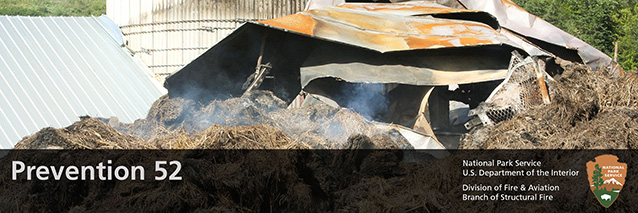
FEMA Photo/Judith Grafe
A pile of dirty rags spontaneously catches fire in someone's garage. Round hay bales stored in a farmer's field go up in flames. Smoke can be seen coming from a city's large compost pile. All three scenarios occur without the addition of flame or heat. Are these stories fact or fiction?
Spontaneous combustion or spontaneous ignition, as it is often called, is the occurrence of fire without the application of an external heat source. Due to chemical, biological, or physical processes, combustible materials self-heat to a temperature high enough for ignition to occur. According to the National Fire Protection Association (NFPA), an estimated 14,070 fires occur annually from spontaneous combustion.
Think something like this cannot occur in your park or home? Think again. A few months ago, an NPS fire crew in the San Francisco Bay area was conducting routine maintenance of their hand tools. One of their tasks involved applying linseed oil with a rag to their tool handles. Even though the crew took precautions with the rag, placing it outside to dry flat on a workbench at the end of the day, the rag caught fire, started the workbench on fire, and spread up the wall of an attached shed. Fortunately, an employee saw the smoke and the fire was extinguished before significant damage occurred.
Rags and towels soaked with oils, including cooking oils; hot laundry left in piles; large compost, mulch, manure, and leaf piles; and moist baled hay can spontaneously combust in the right conditions. Avoid this type of fire by following a few simple and proven tips:
- Store piles of hay, compost, mulch, manure, and leaves away from buildings, in case a fire occurs, and keep the piles small to allow for the circulation of air and the dissipation of heat.
- Work groups or businesses using large quantities of oily rags should dispose of those rags in an OSHA-approved container to await pickup by an industrial cleaning company.
- If you're working on a project at home, spread the soiled rags in a single layer on concrete to prevent the buildup of heat and allow the rags to become hard and brittle. Place the rags out of direct sunlight and secure the corners to prevent movement by wind.
- Hay should be completely dry before baling and moving to a storage facility. Ensure that the facility is well ventilated.
- Dial 911 or your local fire emergency number if your hay bales or mulch, leaf, manure, or compost pile is emitting smoke. The combustible material will need to be spread out to dissipate the rising heat, but the introduction of oxygen can result in an immediate fire. Firefighters should be standing by onsite.
Fire Info for You
Employees
Learn more about spontaneous combustion by viewing an ABC News video with Diane Sawyer, which demonstrates how a linseed oil-soaked rag spontaneously combusted.
Discover more about the NPS fire mentioned above by reading a Facilitated Learning Analysis of the incident.
Firefighters
Increase your knowledge of spontaneous combustion and its occurrences by reading the NFPA report titled, "Fires Caused by Spontaneous Combustion or Chemical Reaction Fact Sheet."
Park Structural Fire Coordinators
Keep watch for unsafe storage and disposal of oily rags in concession facilities and maintenance buildings.
Park Leadership
Prepare standard operating procedures (SOPs) that outline the proper disposal of oily rags and ensure that the proper storage containers are available for use.
Take Action
Walk through your home or workplace and identify spontaneous combustion risks. Immediately remove the risk by taking appropriate measures, such as removing the pile of rags in your garage, or inform management of the fire hazard. Contact the park's safety officer or park structural fire coordinator for approved disposal options.
NPS Fire Facts
According to the U.S. Fire Administration, spontaneous fires are one of the leading causes of fires in agricultural storage facilities, such as barns, silos, and stables. Many NPS sites interpret cultural resources and operate historic farming operations that use or generate materials that can spontaneously combust, such as manure piles or soiled straw. Structures storing hay and grain are at risk for fire, so proper storage of these materials is essential.
Last updated: December 1, 2016
